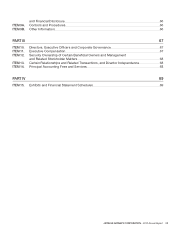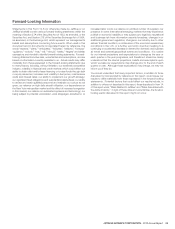JetBlue Airlines 2013 Annual Report Download - page 18
Download and view the complete annual report
Please find page 18 of the 2013 JetBlue Airlines annual report below. You can navigate through the pages in the report by either clicking on the pages listed below, or by using the keyword search tool below to find specific information within the annual report.
JETBLUE AIRWAYS CORPORATION-2013Annual Report12
PART I
ITEM 1Business
Culture
Our People
Our success depends on our Crewmembers delivering the best customer
service experience in the sky and on the ground. One of our competitive
strengths is a service-orientated culture grounded in five key values of
safety, caring, integrity, fun and passion. We believe a highly productive,
engaged workforce enhances customer satisfaction and loyalty. Our goal
is to hire, train and retain a diverse workforce of caring, passionate, fun
and friendly people who share our mission to inspire humanity.
Our culture is first introduced to new Crewmembers during the screening
process and then at an extensive new hire orientation program. The
orientation focuses on the JetBlue strategy and emphasizes the importance
of customer service, productivity and cost control. We provide continuous
training for our Crewmembers including technical training; a specialized
captain leadership training program unique in the industry; a leadership
program for current company managers; an emerging managers program;
regular training focused on the safety value and front line training for our
customer service teams. Our growth plans necessitate and facilitate
opportunities for talent development.
We believe a direct relationship between Crewmembers and our leadership
is in the best interest of our Crewmembers, customers and shareholders.
Currently, none of our Crewmembers have third-party representation, we
have individual employment agreements with each of our FAA licensed
Crewmembers which consist of pilots, dispatchers, technicians, inspectors
and air traffic controllers. Each employment agreement is for a term of five
years and renews for an additional five-year term unless the Crewmember
is terminated for cause or the Crewmember elects not to renew. Pursuant
to these agreements, Crewmembers can only be terminated for cause. In
the event of a downturn in our business, resulting in a reduction of flying
and related work hours, we are obligated to pay these Crewmembers a
guaranteed level of income and to continue their benefits. In addition, through
these agreements we provide what we believe to be industry-leading job
protection language. We believe these agreements provide the Company
and Crewmembers flexibility and allow us to react to Crewmember needs
more efficiently than collective bargaining agreements.
Another aspect of the direct relationship are our Values Committees which
are made up of peer-elected frontline Crewmembers from each of our
major work groups. These Values Committees represent the interest of
our workgroups and help us run our business in a productive and efficient
way. We believe this direct relationship drives higher levels of engagement
and alignment with the Company’s strategy, culture and overall goals.
We believe the efficiency and engagement of our Crewmembers is a result of
our flexible and productive work rules. We are cognizant of the competition
for productive labor in key industry positions and new government rules
requiring higher qualifications and more restricted hours that may result
in potential labor shortages in the upcoming years.
Our leadership team communicates on a regular basis with all Crewmembers
in order to maintain this direct relationship with our people and to keep
them informed about news, strategy updates and challenges affecting the
airline. Effective and frequent communication throughout the organization
is fostered through various means including email messages from our CEO
and other senior leaders at least weekly, weekday news updates to all
Crewmembers, employee engagement surveys, a quarterly Crewmember
magazine and active leadership participation in new hire orientations.
Leadership is also heavily involved in periodic open forum meetings across
our network, called “pocket sessions” which are often videotaped and
posted on our intranet. By soliciting feedback for ways to improve our
service, teamwork and work environment, our leadership team works
to keep Crewmembers engaged and make our business decisions
transparent. Additionally we believe cost and revenue improvements are
best recognized by Crewmembers on the job.
Our full-time equivalent employees at December 31, 2013 consisted of
2,407 pilots, 2,598 flight attendants, 3,586 airport operations personnel,
581 technicians (whom other airlines may refer to as mechanics), 1,025
reservation agents, and 2,833 management and other personnel. At
December 31, 2013, we employed 11,021 full-time and 3,862 part-time
employees.
Crewmember Programs
We are committed to supporting our Crewmembers through a number
of programs including:
•
Crewmember Resource Groups (CRGs). These are groups of
Crewmembers formed to act as a resource for both the group members
as well as JetBlue. These groups serve as an avenue to embrace and
encourage different perspectives, thoughts and ideas. At the end of 2013
we had three CRGs in place: JetPride, Women in Flight, and Vets in Blue.
•
JetBlue Crewmember Crisis Fund (JCCF). Formed in 2002 as a nonprofit
corporation and recognized by the IRS as of that date as a tax-exempt
entity described in Section 501(c)(3) of the Internal Revenue Code, JCCF
was created to assist JetBlue Crewmembers and their immediate family
members (IRS Dependents) in times of crisis. Funds for JCCF grants
come directly from Crewmembers via a tax-deductible payroll deduction.
The assistance process is confidential with only the fund administrator
and coordinator knowing the identity of the Crewmembers in need.
•
Lift Recognition Program. Formed in 2012, this Crewmember recognition
program encourages Crewmembers to celebrate their peers for living
the values by sending e-thanks through an on-line platform. In 2013,
we saw over 47,000 Lift nominations.
Community Programs
JetBlue is strongly committed to supporting the communities and BlueCities
we serve through a variety of community programs including:
•
Corporate Social Responsibility (CSR). The CSR team was established
to support not-for-profit organizations focusing on youth and education,
environment, and community in the cities we serve. They organize and
support community service projects, charitable giving and non-profit
partnerships such as KaBOOM! and Soar with Reading.
•
JetBlue Foundation. Incorporated in 2013 as a nonprofit corporation,
this foundation is a JetBlue-sponsored organization to advance aviation-
related education and to continue our efforts to put aviation on the map as
a top career choice for students. We intend to do this by igniting interest
in science, technology, engineering and mathematics. The foundation is
legally independent from JetBlue and has a Board of Directors as well as
an Advisory Committee, both of which are made up of Crewmembers.
The foundation has applied to the IRS for recognition as a tax-exempt
entity described in Section 501(c)(3) of the Internal Revenue Code.
























